Activation of Rho GTPases triggers structural remodeling and functional plasticity in the adult rat visual cortex
- PMID: 22016550
- PMCID: PMC6623549
- DOI: 10.1523/JNEUROSCI.2617-11.2011
Activation of Rho GTPases triggers structural remodeling and functional plasticity in the adult rat visual cortex
Abstract
A classical example of age-dependent plasticity is ocular dominance (OD) plasticity, triggered by monocular deprivation (MD). Sensitivity of cortical circuits to a brief period of MD is maximal in juvenile animals and downregulated in adult age. It remains unclear whether a reduced potential for morphological remodeling underlies this downregulation of physiological plasticity in adulthood. Here we have tested whether stimulation of structural rearrangements is effective in promoting experience-dependent plasticity in adult age. We have exploited a bacterial protein toxin, cytotoxic necrotizing factor 1 (CNF1), that regulates actin dynamics and structure of neuronal processes via a persistent activation of Rho GTPases. Injection of CNF1 into the adult rat visual cortex triggered a long-lasting activation of the Rho GTPase Rac1, with a consequent increase in spine density and length in pyramidal neurons. Adult rats treated with CNF1, but not controls, showed an OD shift toward the open eye after MD. CNF1-mediated OD plasticity was selectively attributable to the enhancement of open-eye responses, whereas closed-eye inputs were unaffected. This effect correlated with an increased density of geniculocortical terminals in layer IV of monocularly deprived, CNF1-treated rats. Thus, Rho GTPase activation reinstates OD plasticity in the adult cortex via the potentiation of more active inputs from the open eye. These data establish a direct link between structural remodeling and functional plasticity and demonstrate a role for Rho GTPases in brain plasticity in vivo. The plasticizing effects of Rho GTPase activation may be exploited to promote brain repair.
Figures
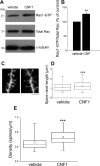
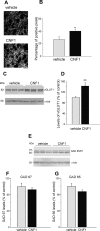
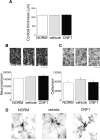
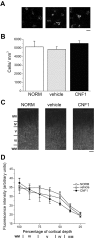
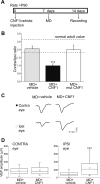
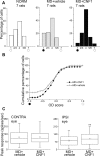

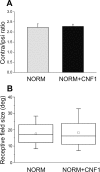
Similar articles
-
Functional masking of deprived eye responses by callosal input during ocular dominance plasticity.Neuron. 2009 Dec 10;64(5):707-18. doi: 10.1016/j.neuron.2009.10.019. Neuron. 2009. PMID: 20005826
-
Vascular endothelial growth factor B prevents the shift in the ocular dominance distribution of visual cortical neurons in monocularly deprived rats.Exp Eye Res. 2013 Apr;109:17-21. doi: 10.1016/j.exer.2012.12.016. Epub 2013 Jan 28. Exp Eye Res. 2013. PMID: 23370270
-
Inhibition of matrix metalloproteinases prevents the potentiation of nondeprived-eye responses after monocular deprivation in juvenile rats.Cereb Cortex. 2012 Mar;22(3):725-34. doi: 10.1093/cercor/bhr158. Epub 2011 Jun 17. Cereb Cortex. 2012. PMID: 21685398
-
The E. coli CNF1 as a pioneering therapy for the central nervous system diseases.Toxins (Basel). 2014 Jan 7;6(1):270-82. doi: 10.3390/toxins6010270. Toxins (Basel). 2014. PMID: 24402235 Free PMC article. Review.
-
Plasticity in the adult brain: lessons from the visual system.Exp Brain Res. 2009 Jan;192(3):335-41. doi: 10.1007/s00221-008-1509-3. Epub 2008 Jul 31. Exp Brain Res. 2009. PMID: 18668231 Review.
Cited by
-
The bacterial toxin CNF1 as a tool to induce retinal degeneration reminiscent of retinitis pigmentosa.Sci Rep. 2016 Oct 24;6:35919. doi: 10.1038/srep35919. Sci Rep. 2016. PMID: 27775019 Free PMC article.
-
Electrophysiology of glioma: a Rho GTPase-activating protein reduces tumor growth and spares neuron structure and function.Neuro Oncol. 2016 Dec;18(12):1634-1643. doi: 10.1093/neuonc/now114. Epub 2016 Jun 13. Neuro Oncol. 2016. PMID: 27298309 Free PMC article.
-
The Cytotoxic Necrotizing Factors (CNFs)-A Family of Rho GTPase-Activating Bacterial Exotoxins.Toxins (Basel). 2021 Dec 15;13(12):901. doi: 10.3390/toxins13120901. Toxins (Basel). 2021. PMID: 34941738 Free PMC article. Review.
-
Fluoxetine increases plasticity and modulates the proteomic profile in the adult mouse visual cortex.Sci Rep. 2015 Jul 24;5:12517. doi: 10.1038/srep12517. Sci Rep. 2015. PMID: 26205348 Free PMC article.
-
Visual cortex plasticity: a complex interplay of genetic and environmental influences.Neural Plast. 2012;2012:631965. doi: 10.1155/2012/631965. Epub 2012 Jul 18. Neural Plast. 2012. PMID: 22852098 Free PMC article. Review.
References
-
- Belichenko PV, Wright EE, Belichenko NP, Masliah E, Li HH, Mobley WC, Francke U. Widespread changes in dendritic and axonal morphology in Mecp2-mutant mouse models of Rett syndrome: evidence for disruption of neuronal networks. J Comp Neurol. 2009;514:240–258. - PubMed
-
- Berardi N, Pizzorusso T, Maffei L. Critical periods during sensory development. Curr Opin Neurobiol. 2000;10:138–145. - PubMed
-
- Bonhoeffer T, Yuste R. Spine motility. Phenomenology, mechanisms, and function. Neuron. 2002;35:1019–1027. - PubMed
MeSH terms
Substances
LinkOut - more resources
Full Text Sources
Other Literature Sources
Research Materials
